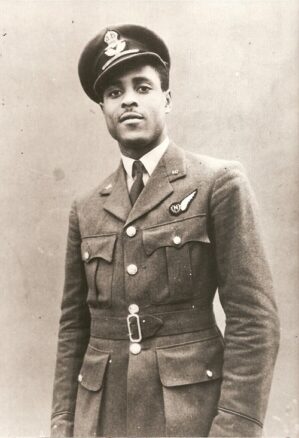Celebrating Black History Month

Born in Sierra Leone, West Africa, John, also known as Johnny joined the Royal Air Force in 1940 at the age of 25, as at the time Sierra Leone was a British colony.
John was selected to train as a navigator due to his mathematic skills. During the war he flew 26 missions as a Short Stirling bomber crew member. His plane was hit by anti-aircraft fire, which resulted in an engine explosion and John was struck. After time in hospital he was transferred to Stalag Luft I, a prisoner-of-war camp in northern Germany and remained there for 18 months.
John was a prisoner until 1945, when one morning his inmates woke to find that all the guards had disappeared due to the news that the Russian Army were heading to Germany.
John returned to London and worked with the Colonial Office, providing welfare for demobilised airmen from the Caribbean and Africa. He later became a senior officer on a captured German troop ship, which had been renamed the Empire Windrush. John was given sole responsibility for demobilising all the Caribbean troops back to their homes at the end of the war. He quickly realised the troops had no work back at home, whilst England needed to be rebuilt, and therefore needed workers. John arranged with both Governments ships to bring these Commonwealth citizens back to the UK, and to get them into jobs and the community.
He continued working with the Colonial Office, however after winning a court case defending a demobilised RAF soldier, despite having had no legal training, he was introduced to the Inns of Court by the presiding judge. John qualified as a barrister in London, before returning to Freetown where he went on to be become the Queen’s Counsel and Sierra Leone’s attorney general.
Like many airman and soldiers, John did not discuss his experiences in the war until much later in life, and suffered greatly with PTSD. Even in his 70’s when an X-ray was taken he still had pieces of shrapnel in his intestine.
John retired and lived in Thame, to be close to his son Eddy, who now resides in Chinnor. John passed away in 1996.
